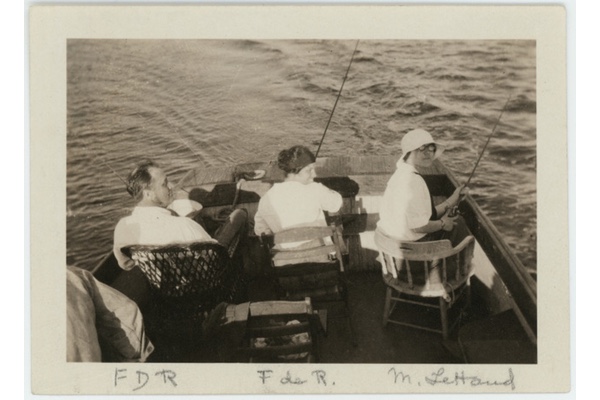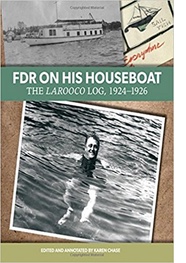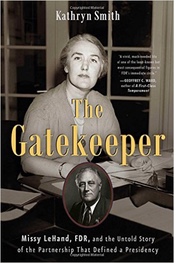FDR and His Houseboat: Another President in Florida

Missy LeHand and FDR fishing, with Frances de Rahm, an old girlfriend of FDR's, between them. (FDR Library)
Donald Trump has drawn criticism and many raised eyebrows over his almost weekly visits to his Mar-a-Lago resort in Florida—now being called the “Winter White House” – since his inauguration. The targets of the criticism range from the cost of providing security to the impropriety of touting a key property of the Trump brand to the presidential access membership to Mar-a-Lago—doubled to $200,000 since his inauguration—gives to the wealthy.
Trump isn’t the first president to have a propensity for Florida vacations. A decade before he became president, Franklin Delano Roosevelt spent many winters in the 1920s exploring the Florida keys on houseboats, one which he rented, another which he bought. They were cut-rate trips; John Lawrence, the co-owner of his houseboat, the Larooco , described it as “a floating tenement.” FDR spent several months each winter from 1923 to 1926 in Florida, with his private secretary Missy LeHand as his hostess and a rotating roster of guests. (His wife, Eleanor, was an occasional visitor.) This gave FDR a taste for prolonged fishing trips that he continued to enjoy—at considerably more expense—on Navy vessels during his presidency. (More controversially, he enjoyed cruises as a guest of Vincent Astor on his mammoth yacht The Nourmahal.)
Two authors of books that examine FDR’s houseboat experiences discuss the importance of getting away from it all for the 32nd president.
Why did you feel compelled to share the Larooco log and Missy LeHand’s story with the world? Did you each feel you were filling a gap in the available scholarship on this subject?
KAREN CHASE When I first laid eyes on the original log, I was smitten. FDR’s log entries in his ratty old black loose-leaf notebook, written in his own hand – what a sight to see! As a poet, I was enticed and intrigued by his use of language, his repetitions, and his passions for water and fishing. The substance of his entries was illuminating – he was funny, fun-loving and brave. To introduce this intimate side of FDR into the historical mix through a little-known primary source felt both important and a privilege.
KATHRYN SMITH I originally started researching Missy because I wanted to read about her and there was no biography in existence. Everything I read in books about FDR or Eleanor Roosevelt portrayed her as either a love-starved secretary or FDR’s mistress and I knew there had to be more about her than that. I definitely filled in a gap in the scholarship by correcting so much of the inaccurate stuff that had been published, and by digging into archives that had not been touched.
So much has been written about FDR over the years. What made this portion of his life so worth revisiting for each of you?
KATHRYN SMITH It’s the time he was in the “wilderness,” searching for a cure to his disability. So much personal growth occurred, and it’s the time when the bond between FDR and Missy became unshakeable. She came to know him as no one else did, and vice versa, and was his most loyal ally.
KAREN CHASE FDR contracted polio in 1921 and, as a result, was no longer able to walk. He bought the houseboat in 1924 in order to focus on healing his paralyzed legs, thinking the warm water and warm air would help. Because these years were the most withdrawn of his adult life, there is relatively little written about this period. His nautical log opens the door to this time, which highlights the intimate and personal rather than the political.
What did you learn from each other’s books that you did not know before reading it?
KAREN CHASE Kathryn’s book further illuminated the relationship between Missy and FDR, which was the prominent relationship during the Larooco years. The ways that their relationship informed his political career are intriguing to read. It continues to amaze me that there is still new material to discover about one of the most written-about figures in American history.
KATHRYN SMITH I had made a stab at reading the logbook, but FDR’s handwriting is so awful that I gave up. Karen’s research showed me a few common mistakes made by other historians which I, unfortunately, repeated because her book came out after mine was published: Eleanor spent more time on the boat than I thought, and Missy and FDR had very few days alone with the crew. There was constant company! It made me even less convinced they had a sexual relationship.
When and how did your interest in FDR begin?
KATHRYN SMITH At the knee of my Georgia grandfather, a yellow dog Democrat (would rather vote for a yellow dog than a Republican).
KAREN CHASE I grew up in a household full of books about Franklin and Eleanor because my parents were big readers, very political, and loved the Roosevelts. When I was 10 years old, I contracted polio and that certainly drew me to him. FDR became a major character in my 2014 memoir, Polio Boulevard, which reflected how integral a figure he had become in my psyche. Bringing his nautical log to the public felt like a tiny repayment to Roosevelt for the courage he gave me and so many others.
What kind of research did you each do while writing your books?
KATHRYN SMITH I read about 125 books about the FDR years and personalities, including many memoirs by the people who worked with Missy. I also researched at the FDR Library and Museum at Hyde Park, the Little White House and Roosevelt Institute in Warm Springs and in the homes of Missy’s great nieces, who had tons of her papers, pictures and possessions, including her home movies! I was also able to interview two elderly women who knew Missy when they were children.
KAREN CHASE My research took many forms. Of course, I read many books that included information about the Larooco years. I spent a great deal of time in the FDR Archives in Hyde Park, NY, scouring files to discover anything I could about the Larooco years. In the fall of 2013, as Visiting Writer at the FDR Homestead, I worked on the log in the Stone Cottage at Val-Kill, not yet restored. Roosevelt had built the house for Eleanor and two friends near the Roosevelt family home. Early each morning, a ranger from the National Park Service would de-alarm the house, unlock the door, and let me in. What a way to start the cold day –- hearing the park ranger’s hometown Roosevelt stories, then being surrounded by the invisible presence of Franklin and Eleanor.
What brand new insights did you each gain about FDR and this period in our nation’s history while writing your books? What surprised or delighted you most?
KAREN CHASE I was surprised by FDR’s sense of humor and playfulness that run through his log entries. His zest for tending to the ordinary details of everyday life is a delight to read. Most importantly, in terms of history, was that FDR’s 3 winters aboard the houseboat gave him the time and space to withdraw from the outer world and focus on himself as a vulnerable human being. The time was formative and lead to his focus on others who were vulnerable. This compassion for others became the bedrock of his presidency.
KATHRYN SMITH It made me respect and admire him even more—all he accomplished. I knew he had started the March of Dimes, but was especially impressed with how he used his presidency to further its work. And what surprised me the most was how powerful Missy was! I had no idea when I started that she was the functional White House Chief of Staff—a position never held by a woman, to this date.
What effect do you think FDR’s time aboard the Larooco and his relationship with Missy LeHand had on his life and political career?
KATHRYN SMITH I think he learned so much about himself during these years, both on the boat and at Warm Springs. Originally, I think he was just trying to escape, and he loved the boat the first couple of years. Then he found the aimless fishing and partying depressing. But he did discover how much the warm water helped his legs, and that led to the years in Warm Springs and his eventual return to public life. Missy was his cheerleader and help-meet during those years. I don’t think he could have done it without her.
KAREN CHASE In terms of the Roosevelt marriage, Franklin and Eleanor set up separate domestic living situations during this period, while Missy became the hostess on the boat. On the rare occasions that Eleanor visited the boat, she was a guest. Politically, the three winters aboard the houseboat gave FDR a respite to synthesize what had happened to him - to be depressed, to work on recovering, and to consider how to proceed. When he was approached about re-entering politics, he said that when he could walk without crutches, he would. But he broke that vow in 1924 when he nominated Al Smith at the Democratic convention -- a moment of glory for FDR.
What lessons from FDR’s time does it seem we might still be learning as a nation? Are we still waging some of the same battles?
KAREN CHASE FDR’s Four Freedoms are very much in the forefront of what we, as a nation, are being challenged by right now: freedom of speech, freedom to worship, freedom from fear, and freedom from want. These battles are all under fire in the current climate.
KATHRYN SMITH History just repeats itself over and over and over again. I do a lot of op-eds for the History News Network, comparing the FDR years to current times. The money-grubbing Roosevelt children are echoed by the money-grubbing Trump children, for example. The isolationism that FDR fought is coming back today, as is the distrust of minorities. I think so much of that is because people don’t know their history. As the old saying goes, “Those who forget the past are condemned to repeat it.”
How might FDR’s legacy be impacted by a Trump presidency? What might FDR have to say about our current state of affairs in US politics?
KATHRYN SMITH I think he’d have a good laugh! Those Republicans! Trump is fast learning that it’s not that easy to govern even when your party is in control of the White House and both houses of Congress. FDR struggled constantly to keep his Democratic coalition together and made many compromises in that regard.
KAREN CHASE The differences between the two men could not be starker. All the programs that FDR implemented and stood for are threatened by Trump’s tough-guy posturing. If Trump has his way, the nation will spend needlessly on defense and border control for starters. What might FDR say? Fight like hell so that the policies and programs that benefit the average citizen are not dismantled!
What do you hope readers take away from your books?
KAREN CHASE So much has been written about Roosevelt, the public man. The Larooco log underscores a different side of him during a little-known time in his life. Through FDR’s own words, I hope readers will discover his courage, humor, perseverance and ability to overcome adversity via the original source of his nautical log.
KATHRYN SMITH That a quiet and effective woman had a huge impact on FDR’s presidency—and she did it while behaving like a lady.

